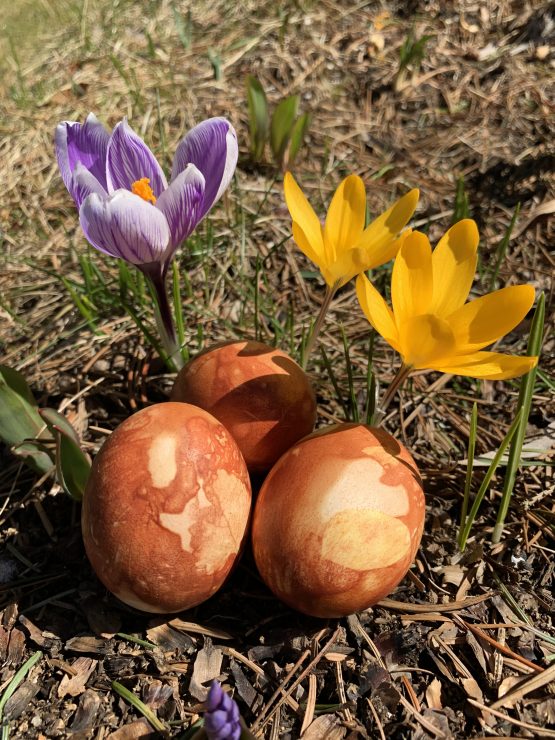From shrink wrap to onion skins, here are my favourite ways to dye eggs

Photo by Hannah Link.
Easter is my favourite holiday, and I don’t even believe in God. To me, Easter is all about that fresh, new feeling that you can smell in the air when spring starts. It’s a sign that summer is coming, even if many Easters in my northern hometown were still accompanied by old snow on the ground (which never seemed to bother the Easter Bunny, thankfully).
One great thing about Easter (besides the chocolate) is the craft of dyeing eggs, and there are so many fun ways to colour an egg that you can try out this year. Here’s a list of my favourites:
Dip dyed
This is a tried and true classic. Just pick up a grocery store egg-dyeing kit, which will include little pellets of colour that you combine with water (and sometimes vinegar) to create proper egg dye. There are lots of options to make a dip dyed-egg more interesting, like only submerging half of the egg in the dye and creating a layered effect. Some dye-hard egg decorators make their own dyes using food colouring or more natural ingredients, like turmeric and beet juice. I quite like the look of a solid, vibrant egg at easter. I also like that they’re simple enough that they’re hard to mess up.
Shrink wrapped
Each Easter my Dad would buy whichever egg-dyeing kit was on sale, so sometimes he would come home with ones that included shrink wrapping for the eggs. This is a very simple method of egg decoration because the art is essentially done for you. All you have to do is place the colourful plastic sleeve around an egg and boil it until the wrapper has shrunk. Despite its simplicity, this method fascinated me as a child and it’s also relatively foolproof.
Ukrainian pysanky
These eggs are mesmerizingly intricate and require much more artistic talent, dexterity, and patience than I possess. Very fine lines of melted wax are “drawn” on the egg before it is dipped in dye, starting with a light colour. This process is repeated over and over with darker colours until various patterns are preserved, leaving behind beautiful, ornate designs. The world’s largest pysanky is located in Vegreville, A.B., and the Queen herself once visited it.
Onion eggs
I learned this method of egg-decorating from my Baltic German mother, though Google can’t seem to tell me from where exactly this tradition originates. It involves a rather exciting and somewhat nerve wracking multi-step process. First, you gather small leaves and flowers from your backyard and arrange them against the egg, using water to make them stick. Then you wrap the egg in onion skins (more than you’d think) and wrap the whole bundle in fabric, tying it tightly with string. When we do this at my cousins’ house, they attach buttons to each egg parcel so we can identify whose creation is whose. The parcel is then boiled, and the cloth and skins are removed to reveal golden eggs with white leaf and flower designs which were spared from the colour.
Washable marker
This one is my dad’s only way of decorating eggs. Every year he would bring out our large bin of Crayola markers and decorate his allotted eggs by colouring patterns onto them. The opportunities are endless here, but a permanent marker is probably the way to go if you want your designs to stay put. I’ve never asked him why he prefers this method over the dip dye that he buys for us, so maybe this Easter I will.
However you decorate, hopefully this list can provide some inspiration for your egg-colouring journey this year. And if after all this you choose to forgo the decoration process altogether because it’s almost finals and you really don’t like hard-boiled eggs that much, I understand.








